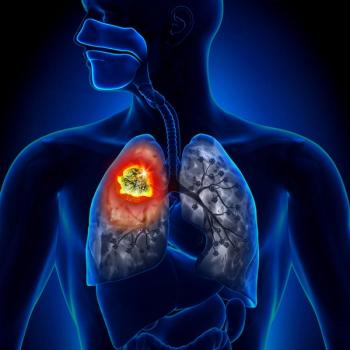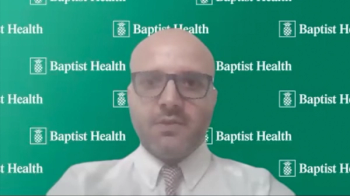
- ONCOLOGY Vol 11 No 9
- Volume 11
- Issue 9
Precise Clinical Staging Allows Treatment Modification of Patients With Esophageal Carcinoma
Treatment of esophageal carcinoma requires the realization that this neoplasm is not a single entity with a uniformly poor prognosis. As with any other malignancy, disease stage has prognostic and therapeutic
ABSTRACT: Treatment of esophageal carcinoma requires the realization that this neoplasm is not a single entity with a uniformly poor prognosis. As with any other malignancy, disease stage has prognostic and therapeutic importance. Patients with stage T1-2,N0,M0 or lower tumors have acceptable surgical cure rates and should undergo immediate resection. Patients with more advanced tumors (T3 or N1) are still potentially curable but do poorly with surgery alone. These patients should be considered for multimodality therapy. Patients with hematogenous metastatic disease should be treated with palliative intent. Endoscopic ultrasound (EUS), an accurate, reproducible staging tool, allows for clinical staging of these patients and modification of treatment at the time of diagnosis. Our experience at The Cleveland Clinic Foundation using this algorithm of surgery alone in patients with EUS-defined early-stage carcinomas and multimodality therapy in patients with EUS-staged locally advanced disease is described. [ONCOLOGY 11(Suppl 9):58-62, 1997]
The American Cancer Society estimates that in 1996, 12,300 patients were diagnosed with esophageal cancer and 11,200 died from this disease.[1] These data suggest an annual mortality in excess of 90%. Causes for this dismal prognosis are multiple and include tumor, treatment, and patient factors.
Unfortunately, the majority of patients with this neoplasm still present only after the development of dysphagia, a manifestation of advanced disease. Successful surgical resection is difficult due to the propensity of this tumor to spread rapidly through the esophageal wall into adventitial tissue and regional lymph nodes.
Locoregional disease remains the most common reason for treatment failure. Delivery of effective high-dose radiation therapy is complicated by the proximity of the esophagus to critical mediastinal structures, the lungs, and spinal cord. Chemotherapy alone, whether with single agents or multiple-drug combinations, is generally not curative and is ineffective in controlling this disease. The comorbidity often found in patients with this neoplasm is an additional complicating factor.
An extensive review of the literature performed by Earlam and Cunha-Melo[2] in 1980 estimated a 4% overall survival after surgical resection of esophageal carcinoma, and a surgical mortality of 29%. Radiation therapy alone achieved similar success, with an overall survival of 6%.[3] These unacceptable results have led many physicians to consider the treatment of esophageal carcinoma a palliative practice, with cure a serendipitous event.
From 1974 to 1991, there was a modest but statistically significant improvement in the survival of patients with esophageal carcinoma, although the 5-year survival is still only 7% to 11%.[1] Is there hope for patients with esophageal cancer, or will their prognosis continue to be dismal?
First, it must be realized that the surgical mortality reported in earlier series is excessive and no longer acceptable. Most major medical centers now consistently report surgical mortality figures of 5% to 10%. While still formidable, these are much more acceptable surgical risks, particularly when coupled with generally reported surgical cure rates of 10% to 20%. At the Cleveland Clinic Foundation in Ohio, the 5-year survival of all patients with surgically resected esophageal cancer is 18%, with a surgical mortality of 6%.
Second, it must be recognized that improvement in the treatment of this disease begins with the concept that esophageal carcinoma is not a single entity with a uniformly dismal prognosis. Unfortunately, current clinical staging is limited in its ability to preoperatively identify patients who will benefit from surgery. Both primary disease extent and regional nodal spread are prognosticators but are inaccessible to physical examination and are only poorly characterized endoscopically or radiographically.
Therefore, it has been difficult to clinically separate patients who may benefit from aggressive surgical therapy from those best treated palliatively. Accordingly, the results of series reporting the surgical management of all patients have been poor. If treatment results are analyzed by pathologic stage, however, a subgroup of patients with an acceptable prognosis after surgical resection can be retrospectively identified.
The present staging system for esophageal carcinoma is a pathologic one, based on the depth of tumor invasion (T), the status of regional lymph nodes (N), and distant sites (M).[4] (Table 1) Although conceptually obvious and consistent with other gastrointestinal tumors, this simple staging system represents a significant advance in the treatment of esophageal carcinoma because it allows for the prognostic stratification of patients and appropriate treatment planning.
T-Status
In node-negative (N0) patients without evidence of distant metastases (M0), the depth of tumor invasion is the critical factor affecting survival. Patients with high-grade dysplasia (Tis; intraepithelial carcinoma) and T1 intramucosal carcinomas (carcinomas limited to the lamina propria and muscularis mucosa) have similar 5-year survival rates after surgery (80% to 85%).[5] However, in node-negative (N0) patients, when the tumor breaches the muscularis mucosa, survival falls dramatically.
Our data suggest that there is no difference between T1 submucosal and T2 carcinomas (tumors that invade but do not breach the muscularis propria), with a 5-year survival of 40% to 50% for each.[6] When the tumor invades beyond the muscularis propria (T3), survival falls even further (< 25% at 5 years).
N1 Disease
Stratification by T-status is unnecessary if regional lymph node metastases (N1) have occurred. In our experience, the survival rates for patients with T1,N1,M0, T2,N1,M0, and T3,N1,M0 carcinomas are similar and are much worse than those for patients with T3,N0,M0 carcinomas.[6] Although survival of patients with N1 disease is independent of T-status, an important relationship between T and N1 exists.
The esophagus is unique among gastrointestinal hollow viscus organs in that its lymphatics are found in the lamina propria and muscularis mucosa. In the stomach and small and large intestines, lymphatics are not encountered by invading tumors until they reach the submucosa. This superficial presence of lymphatics results in a small but significant incidence (5%) of regional lymph node metastases (N1) in T1 intramucosal carcinomas.[5]
As the tumor invades deeper into the esophageal wall, the rate of regional lymph node metastases (N1) increases, with positive regional lymph nodes found in approximately 25% of T1 submucosal tumors, 40% to 50% of T2 tumors, and 80% of T3 or T4 tumors. Since no lymphatics penetrate the basement membrane, regional lymph node metastases are not seen in high-grade dysplasia (Tis) carcinomas.
There is a small population of patients with N1 disease who will have long-term survival after surgery alone. Metastatic burden is a prime predictor of survival for these patients. In our experience, as the absolute number and percentage of positive nodes in a resection specimen increase, there is a corresponding decrease in survival. Patients with three or fewer positive nodes or those in whom less than 10% of resected nodes are positive will have a two- to threefold better chance of 5-year survival than the group as a whole.
M1 Disease
The definition of M1 disease includes the involvement of distant nodal station (eg, supraclavicular and celiac) as well as blood-borne metastases. Distant hematogenous metastatic disease precludes long-term survival. Although considered M1 disease by definition, our experience suggests that celiac axis lymph node metastases (M1) in esophagogastric junction carcinomas may not reduce survival any more than do regional lymph node metastases (N1). Our practice is to treat this subset of M1 carcinomas in the same way that we treat those with regional lymph node metastases.
Accurate clinical staging is necessary for appropriate treatment decisions and prognostication. The development and refinement of endoscopic ultrasound (EUS) and its application to the clinical staging of esophageal carcinoma is a major advance. Clinical staging can now be accomplished with an accuracy of 80% or more for both primary tumor extent (T) and regional nodal involvement (N)an accuracy not possible with any other staging modality.[7,8]
Once distant metastatic disease is excluded by CT scanning, EUS is performed so as to detect both regional lymph node metastases (N1) and invasion beyond the esophageal wall (T3 or T4). Although several technical limitations do exist, these generally do not detract from the overall staging effort. First, EUS does not adequately identify the boundaries between the epithelium, lamina propria, and muscularis mucosa and microinvasion of the submucosa may be difficult to detect.
However, differentiation of the depth of tumor invasion of these superficial carcinomas does not have an impact on therapy. If these patients are medically fit, they represent the group with the best survival following resection. Current EUS equipment is not useful in the surveillance of patients with Barrett's esophagus.[9] Even in superficial carcinomas, the role of EUS is limited to excluding the regional lymph node metastases.
A second limitation of EUS is its inability to scan the entire malignant stricture in approximately 20% of symptomatic patients. The inability to pass the EUS probe through a malignant stricture, however, provides an accurate and sensitive staging sign. More than 90% of patients will have stage III or IV carcinomas. This is a prognostic accuracy greater than that obtained if only an incomplete examination above the stricture is performed, and patients with this finding are clinically diagnosed with locally advanced carcinomas.[10]
Surgical Resection
While patients with esophageal carcinoma confined to the esophageal wall without regional lymph node metastases remain a minority, the recent significant increase in adenocarcinoma and the successful use of endoscopic surveillance of patients with Barrett's esophagus allow for the early identification of these patients and the even earlier subgroup with high-grade dysplasia alone. Patients with these superficial carcinomas have an excellent prognosis after surgical resection, thus justifying aggressive screening procedures and aggressive management.
In the past, when patients were not stratified by stage, the philosophy of management was often only palliative. Today, it is evident that patients with pathologically staged T1-2,N0 disease who undergo resection have a 5-year survival in excess of 50%.[5,6] Preoperative identification of these patients, using endocopic ultrasound to assign a clinical stage, is crucial.
Multimodality Therapy
With carcinomas extending beyond the esophageal wall or with regional lymph node metastases, surgery alone is rarely curative. In these patients, alternate, usually multimodality therapies must be considered. Chemotherapy with or without radiation is common
in such aggressive multimodality treatment.[11-13]
Several chemotherapy strategies have been employed. Induction, or neoadjuvant, chemotherapy alone is reported to produce significant responses, particularly cisplatin (Platinol)-based regimens.[14,15] Surgery is then possible without any increase in perioperative mortality. Although an occasional pathologic complete responder has been reported with this approach, results from randomized trials have failed to confirm an overall survival benefit.[16,17]
Despite reported response rates as high as 65% after induction chemotherapy, the methodology of response assessment is subject to question.[18,19] Our group previously reported that symptomatic and endoscopic response assessments after induction chemotherapy are falsely high when compared with endoscopic ultrasound or pathologic response rate.[14]
More aggressive treatment schedules, utilizing concurrent fluorouracil (5-FU)-based chemotherapy and radiation, have now undergone extensive phase II and several phase III clinical trials. Two cooperative groups have reported a survival advantage when this concurrent approach is compared with radiation alone, with a projected 5-year survival of 30% after concurrent treatment in the Intergroup study.[20,21]
Is Surgery Necessary?
These encouraging results without resection, and the significant surgical mortality reported by many institutions after chemoradiotherapy, lead many practitioners to question whether there is a role for surgical resection in these patients with locoregionally advanced disease.[22,23]
Walsh and colleagues[24] recently reported the results of a phase III comparison of surgery alone vs induction chemoradiotherapy followed by surgery. Multimodality treatment provided a significant survival advantage, with a projected 3-year survival of 32%, as compared with 6% after surgery alone.
This result was not duplicated in a similar study reported in 1995 by Urba and colleagues.[25] Both of these trials can be criticized for the lack of pretreatment staging in the chemoradiotherapy group, possibly allowing for a significant staging bias favoring one arm or another. Although the superiority of chemoradiotherapy over radiotherapy alone in this disease is established, the role of surgical resection and the potential benefit of preoperative chemoradiotherapy are less clear.
At the Cleveland Clinic Foundation we have completed a large phase II trial of induction chemoradiotherapy followed by surgical resection.[26] Our results are not randomized but are most encouraging and suggest the importance of surgical resection.
A total of 72 patients, 48 with adenocarcinoma and 24 with squamous- cell carcinoma, underwent induction chemoradiotherapy with two courses of 5-FU and cisplatin and a split course of accelerated fractionation radiation to a total preoperative dose of 45 Gy. All patients were subsequently referred for surgical resection, and a single identical postoperative chemoradiotherapy course was administered to patients with residual disease at surgery.
Toxicity was significant but manageable. Surgery was performed in 67 (93%) patients, 65 (90%) of whom were resectable. Of the 67 surgical patients, 12 (18%) died perioperatively and 18 (27%) had no pathologic evidence of residual disease. No patient who completed induction therapy and surgery experienced a locoregional recurrence.
With a median follow-up of 24 months, the Kaplan-Meier 4-year projected relapse-free and overall survival rates are 49% and 44%, respectively. In the 62 patients in whom pretreatment ultrasound staging indicated T3, N1, or M1 (nodal) disease, the 4-year projected overall survival is 42%.
The importance of the addition of surgery to induction therapy is suggested by the observation that no patient completing chemoradiotherapy and surgery experienced a locoregional disease recurrence despite findings of residual viable tumor in 73% of surgical specimens. In the Intergroup nonsurgical trial of chemoradiotherapy alone, 44% of patients experienced locoregional disease persistence or recurrence.[20] In our experience, locoregional disease control was achieved at a significantly increased operative mortality. Nonetheless, the overall projected survival is encouraging, particularly when viewed historically.
If pathologic complete response after chemoradiotherapy could be identified, surgical resection and its resultant morbidity and mortality could be avoided. Unfortunately, it was clinically impossible to accurately predict which patients achieved a pathologic complete response after induction chemoradiotherapy, based on any of the following criteria: symptomatic relief, barium swallow improvement, chest CT scan improvement, normalization of upper endoscopy, or endoscopic ultrasound evaluation. Thus, surgical resection remains an integral and important part of our multimodality treatment of esophageal carcinoma.
Esophageal carcinoma is no longer a disease with a uniformly dismal prognosis. The prognosis of patients with esophageal carcinoma depends on the extent of the disease at presentation. Patients with early tumors are being increasingly identified due to aggressive screening of high-risk populations. Such patients do relatively well with surgical resection alone. Whether any benefit can be gained by the addition of other treatment modalities has not yet been determined.
For the majority of patients who present with locoregionally advanced but nonmetastatic disease, current treatment approaches using chemotherapy and radiation have produced encouraging results both with and without surgical resection. Further investigation is required, however, to determine the most appropriate chemotherapeutic agents, radiotherapy fractionation schedules, and sequencing of treatment modalities.
Our practice is to clinically stage patients with esophageal carcinoma with EUS. This information defines our treatment approach. Endoscopic ultrasound can separate patients with regional lymph node metastases (N1) from those without regional lymph node metastases (N0), and N0 patients can be further stratified by T-status.
All patients with a clinical stage of T2,N0,M0 or less who are medically suitable for surgery are considered for immediate resection. Postoperative adjuvant therapy is reserved for resected patients who have a more advanced pathologic stage.
Patients with clinical stage T3,N0,M0 or greater carcinomas are considered for multimodality treatment approaches utilizing induction chemoradiotherapy followed by resection. Patients with esophagogastric junction tumors and metastases confined to the celiac axis are treated in the same manner as are patients with N1 carcinomas. All other M1 patients are considered for nonsurgical palliation.
Stratification of treatment by precise clinical staging will improve the care of our patients and represents the successful application of EUS-based clinical staging in treatment planning. This established practice may well lead to therapeutic advances.
References:
1. Parker SL, Tong T, Bolden S, et al: Cancer statistics 1996. CACancer J Clin 46:5-27, 1996.
2. Earlam R, Cunha-Melo JR: Oesophageal squamous cell carcinoma: A critical review of surgery. Br J Surg 67:381-390, 1980.
3. Earlam R, Cunha-Melo JR: Oesophageal squamous cell carcinoma: A critical review of radiotherapy. Br J Surg 67:457-461, 1980.
4. Beahrs OH, Henson DE, Hutter RVP, et al: Manual for StagingCancer. 4th ed, pp 57-59. Philadelphia, J B Lippincott, 1992.
5. Sabik JF, Rice TW, Goldblum JR, et al: Superficial esophageal carcinoma. Ann Thorac Surg 60:896-902, 1995.
6. Killinger WA, Rice TW, Adelstein DJ, et al: Stage II esophageal carcinoma: The significance of T and N. J Thorac Cardiovasc Surg 111:935-940, 1996.
7. Rice TW, Boyce GA, Sivak MV Jr: Esophageal ultrasound and the preoperative staging of carcinoma of the esophagus. J Thorac Cardiovasc Surg 101:536-544, 1991.
8. Rice TW, Boyce GA, Sivak MV Jr, et al: Esophageal carcinoma: Esophageal ultrasound
assessment of preoperative chemotherapy. Ann Thorac Surg 53:972-977, 1992.
9. Falk GW, Catalano MF, Sivak MV Jr, et al: Endosonography in the evaluation of patients with Barrett's esophagus and high-grade dysplasia. Gastrointest Endosc 40:207-212, 1994.
10. Van Dam J, Rice TW, Catalano MF , et al: High-grade malignant stricture is predictive of esophageal tumor stage. Risks of endoscopic evaluation. Cancer 71:2910-2917, 1993.
11. Ilson DH, Kelsen DP: Management of esophageal cancer. Oncology 10:1385-1402, 1996.
12. Philip PA, Ajani JA: Has combined modality therapy improved the outlook in carci-
noma of the esophagus? Oncology 8:37-42, 1994.
13. Kelsen DP: Adjuvant therapy of upper gastrointestinal tract cancers. Semin Oncol 22:582-599, 1995.
14. Adelstein DJ, Rice TW, Boyce GA, et al: Adenocarcinoma of the esophagus and gastroesophageal junction: Clinical and pathologic assessment of response to induction chemotherapy. Am J Clin Oncol 17:14-18, 1994.
15. Carey RW, Hilgenberg AD, Wilkins EW, et al: Preoperative chemotherapy followed by surgery with possible postoperative radiotherapy in squamous cell carcinoma of the esophagus: Evaluation of the chemotherapy component. J Clin Oncol 4:697-701, 1986.
16. Roth JA, Pass HI, Flanagan MM, et al: Randomized clinical trial of preoperative and postoperative adjuvant chemotherapy with cisplatin, vindesine, and bleomycin for carcinoma of the esophagus. J Thorac Cardiovasc Surg 96:242-248, 1988.
17. Kelsen DP, Minsky B, Smith M, et al: Preoperative therapy for esophageal cancer: A randomized comparison of chemotherapy vs radiation therapy. J Clin Oncol 8:1352-1361, 1990.
18. Kelsen DP, Heelan R, Coonley C, et al: Clinical and pathological evaluation of response to chemotherapy in patients with esophageal carcinoma. Am J Clin Oncol 6:539-546, 1983.
19. Agha FP, Gennis MA, Oringer MB, et al: Evaluation of response to preoperative chemotherapy in esophageal and gastric cardia cancer using biphasic esophagrams and surgical pathologic correlation. Am J Clin Oncol 9:227-232, 1986.
20. Herskovic A, Martz K, al-Sarraf M, et al: Combined chemotherapy and radiotherapy compared to radiotherapy alone in patients with cancer of the esophagus. N Engl J Med 326:1593-1598, 1992.
21. Sischy B, Ryan L, Haller D, et al: Interim report of EST 1282 phase III protocol for the evaluation of combined modalities in the treatment of patients with carcinoma of the esophagus, stage I & II (abstract). Proc Am Soc Clin Oncol 9:105, 1990.
22. Poplin E, Fleming T, Leichman L, et al: Combined therapies for squamous cell carci-
noma of the esophagus, a Southwest Oncology Group study (SWOG-8037). J Clin Oncol 5:622-628, 1987.
23. Coia LR: Chemoradiation as primary management of esophageal cancer. SeminOncol 21:483-492, 1994.
24. Walsh T, Noonan N, Hollywood D, et al: A comparison of multimodal therapy and surgery for esophageal adenocarcinoma. NEngl J Med 335:462-467, 1996.
25. Urba S, Orringer M, Turrisi A, et al: A randomized trial comparing transhiatal esophagectomy to preoperative chemoradiation followed by esophagectomy in locoregional carcinoma (abstract). Proc Am Soc ClinOncol 14:199, 1995.
26. Adelstein DJ, Rice TW, Becker M, et al: Concurrent chemotherapy, accelerated
fractionation radiation and surgery for esophageal cancer (abstract). Proc Am Soc Clin Oncol 15: 203, 1996.
© 1997 by PRR, Inc. All rights reserved.
Articles in this issue
about 28 years ago
UFT: East Meets West in Drug Developmentabout 28 years ago
Rationale for Phase I Study of UFT Plus Leucovorin and Oral JM-216about 28 years ago
Postoperative Adjuvant Chemotherapy for Non-Small-Cell Lung Cancerabout 28 years ago
UFT in Gastric Cancer: Current Status and Future Developmentsabout 28 years ago
Oral UFT and Leucovorin in Patients With Advanced Gastric CarcinomaNewsletter
Stay up to date on recent advances in the multidisciplinary approach to cancer.



















































































